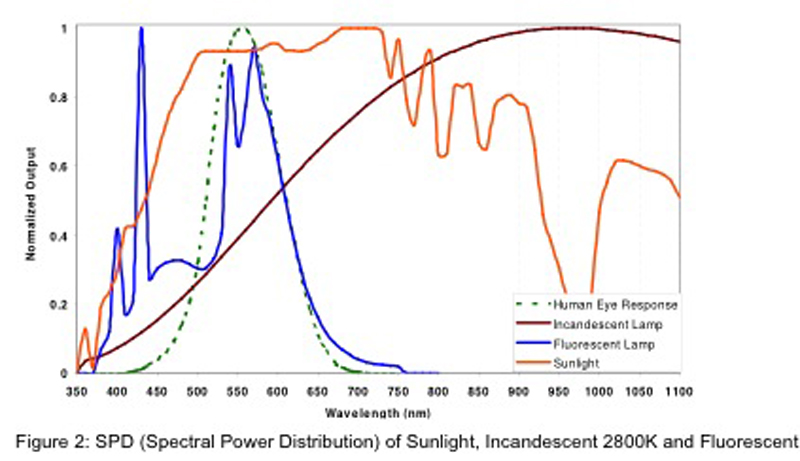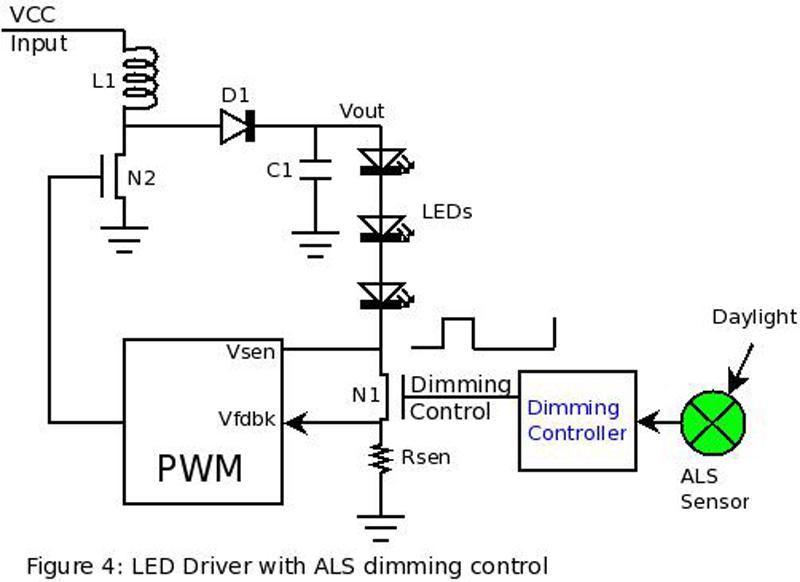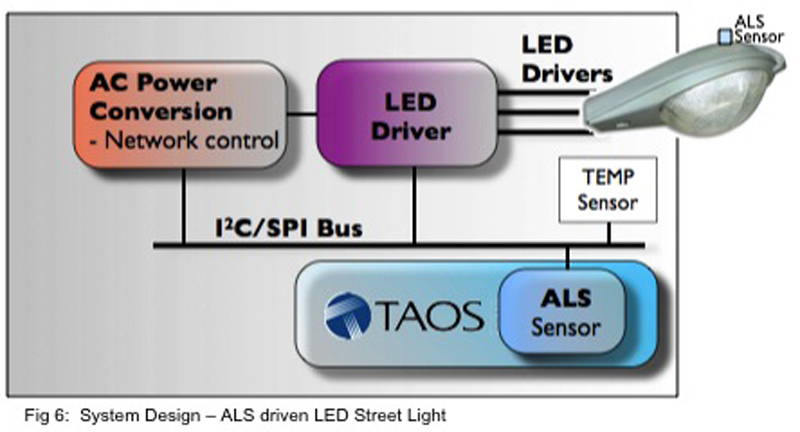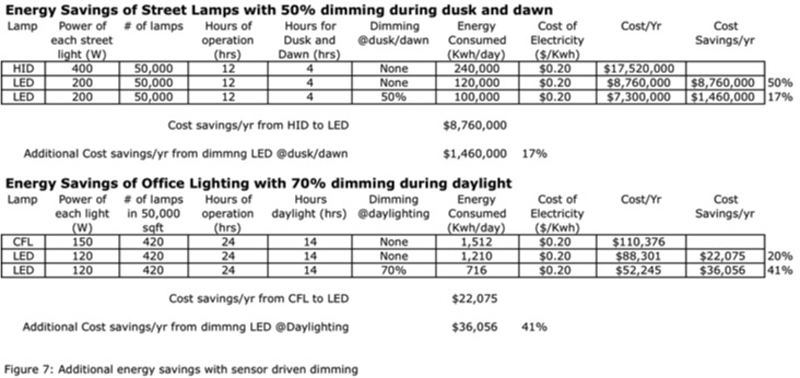Author:
Sajol Ghoshal, Business Unit Manager for Advanced Platform Texas Advanced Optoelectronic Solutions (TAOS)
Date
10/19/2011
Over 20% of the energy consumed in the US is in lighting; in fact, next to heating and air conditioning systems, lighting systems account for the greatest energy. Today, adequate daylight is available through skylights and open windows - however this daylight cannot be harvested without sensors. Ambient Light Sensors (ALS) enable "Green" energy-efficient solid-state lighting solutions by contributing to substantial energy savings. Sensors, enabling autonomous energy management, will drive the next level of energy conservation. With the higher efficacy of LEDs (Light Emitting Diodes; Lumens/Watt), there is a strong drive to replace energy consuming incandescent/HID/CFL lamps with LEDs. The growth of LEDs started in mobile backlighting for smartphones to improve battery life of cell phones, and then rapidly migrated toward large screen TV displays, monitors and laptops for energy reduction. Today, this LED growth has entered the general illumination market that covers commercial/industrial lighting contained in office buildings, institutions (schools, hospitals, government buildings etc.), warehouses, big box retail stores, grocery stores, hotels, restaurants and other industrial facilities. Although LED replacement lighting will provide about 50% reduction in energy consumption, these environments can benefit from an additional 30% energy reduction by exploiting daylight harvesting. Daylighting harvesting uses light from the sun that penetrates these building from windows and skylights to reduce the internal electric lighting needed while providing adequate workspace lighting. LED Drivers with Dimming Controls LEDs are generally driven by a fixed current specified by the manufacture to maintain the correct color. LEDs have the capability of being dimmed from 0 to 100% by modulating the duty cycle of the fixed current through the use of the dimming control FET (N1) - see Figure 1 (LED Driver with Dimming Control) of a boost converter LED controller for a constant current LED driver.

The PWM controls the buck converter consisting of L1, D1 and N2 delivering the lowest voltage, Vout, needed to maintain the LED's fixed current. The fixed current is set by the value of the Rsen resistor. The voltage on the top of the Rsen resistor is fed into the PWM at the Vfdbk node. The Vfdbk voltage is compared against an internal fixed voltage, say 0.4V to control Vout. Therefore, to fix the constant current through LED for say 350ma, Rsen = 0.4/0.35 = 1.14 ohms. The forward voltage of a WLED is between 3 to 4 Volts. So if there are 3 series LEDs, the Vout can vary between 9.4V to 12.4V, for more LEDs in series the Vout will adapt and go higher. Vsen is used to detect opens and shorts based on the acceptable range of this voltage. The frequency of the dimming controller should be above 120Hz to prevent any detectable flicker from the human eye, although it is preferred to operate it above the audible range of 20 KHz as some inductors and capacitors will generate audible noise when dimmed at less than 20kHz.

ALS Sensors That Distinguish Daylight from Electric Light It can be seen from Figure 2 (SPD - Spectral Power Distribution - of Sunlight, Incandescent 2800K and Fluorescent) and Figure 3 (SPD - Spectral Power Distribution - of Monochromatic LED and typical White LED) that common light sources have dramatically different energy spectrums. The ALS sensors from TAOS have the ability to distinguish between these different spectrums and determine the actual amount of ambient light available. In addition, since the fast-acting LEDS are modulated on and off very quickly, the ALS sensors can measure the ambient light when the LED is off and integrate this information across multiple cycles of OFF states. This data can then be used to determine how much electric light to add to the overall lighting to meet the lighting needs of the workspace.

ALS Sensors-Driven LED Driver The LED driver described above cannot adapt to external light. An ALS sensor connected to the dimming control can adapt the LED duty to adjust the intensity of the LED output light, thus compensating for the additional daylight by dimming the LED light - see Figure 4 (LED Driver with ALS Dimming Control). If there is bright sunlight entering the environment, the Dimming Controller can adjust the dimming duty to close to zero or zero to maintain the set Lumens/sq feet that is needed for the workspace. In the evening, when there is no daylight, the ALS detector will indicate no light and then the Dimming Controller will increase the duty cycle higher to increase light intensity. Generally, LED drivers are designed to operate at 70-80% duty cycle such that when the LED intensity declines with age or with temperature the duty cycle can be adjust up to 90-95% to accommodate the reduction in light intensity (LEDs intensity declines 10-15% at 85degC from nominal and increase at low temperatures).

ALS Sensor Location and Positioning Electric lighting systems -- with carefully integrated daylight harvesting sensors that measure the amount of light in different areas of a given room -- can be used with a room lighting controller to adjust the light for different parts of the room through sensors. Figure 5 (ALS Sensors Positioned in around of the Room) illustrates how sensors can take advantage of the daylight from the front windows and minimize the amount of electric light used in the front of the room. The ALS sensors - positioned on the wall -- can provide feedback to increase the intensity of lights in the back of the room to provide adequate illumination, while saving energy through daylight sensing. Sensors can also be integrated into overhead lighting. In addition, standalone sensors are important to provide feedback on the amount of light at different locations, like the windows, columns, and desktops. This lighting information by location is used to control the brightness of different lights in the room.

Sensor-Driven LED Driver Architecture The TAOS ALS sensor, the TSL4531, can be used in the closed loop architecture to control the LED light on a street lamp. See Figure 6 (System Design - ALS-Driven LED Street Light). As evening approaches, the LED lamps will turn on, adjusting the dimming control so that the light turn on fully only when it is dark. The same behavior applies in reverse as dawn approaches.

Energy Savings with Daylight-Driven Dimming of Office or Street Lighting As we can see in Figure 7 (Additional Energy Savings with Sensor-Driven Dimming), although there is a savings of 50% going from HID street lamps to LED street lamps, an additional 17% can be saved by dimming the street lights during dusk and dawn by 50%. In office lighting that is on for 24 hours, an additional 41% savings is achieved by daylighting. Key Technical Specs for TSL4531 The TAOS product portfolio contains a broad spectrum of intelligent light sensing solutions that enable customers to design "green" system-level end products for use in indoor and outdoor solid-state lighting applications. The next generation TAOS TSL4531 digital ambient light sensor is designed for general illumination, outdoor lighting and automotive energy-saving LED lighting applications. The TSL4531 has a wide dynamic range of 3 to 220k Lux and rejects 50Hz/60Hz lighting ripple. It measures luminance in Diverse Lighting Conditions (bright sunlight to darkened rooms), making it ideal for next generation energy-efficient sensor driven LED lighting solutions. Application of Sensor Driven LED lighting This autonomous energy management can be achieved by incorporating ALS light sensors into LED lighting with integrated dimming controls. ALS sensors that accurately distinguish mixed daylight from electric light operate a bi-level or multi-level lighting system that enables automatic reduction of electric lighting in buildings by exploiting daylight harvesting while maintaining appropriate light levels in the workspace. This capability can be extensively deployed in the following examples for indoor and outdoor lighting in: • Office lighting • Grocery store lighting • Retail/warehouse lighting • Street lighting • Outdoor/sidewalk lighting With ALS sensors integrated into lighting, large office buildings with glass windows or skylights can automatically dim their lights for most of the day, thereby adding an additional ~30% in energy savings. In some cases, the LED lights could dim to 30% of normal brightness before human beings are aware there is less illumination. ALS sensors are big energy savers for outdoor lighting (canopy lights, parking garages, wall washes, sidewalk lighting, etc.) and street lighting, with dusk to dawn dimming controls adding another 20% of additional energy savings. Autonomous energy-managed LED lights will provide far more energy and cost savings than just the normal consumption compared to CFL/HID/incandescent lights, making every consumer/enterprise a participant in the Green Energy savings by reducing the carbon footprint of the planet, without the consumer changing their current behavior, thereby accelerating the adoption of LED lighting in the fast growing general illumination market. www.taosinc.com